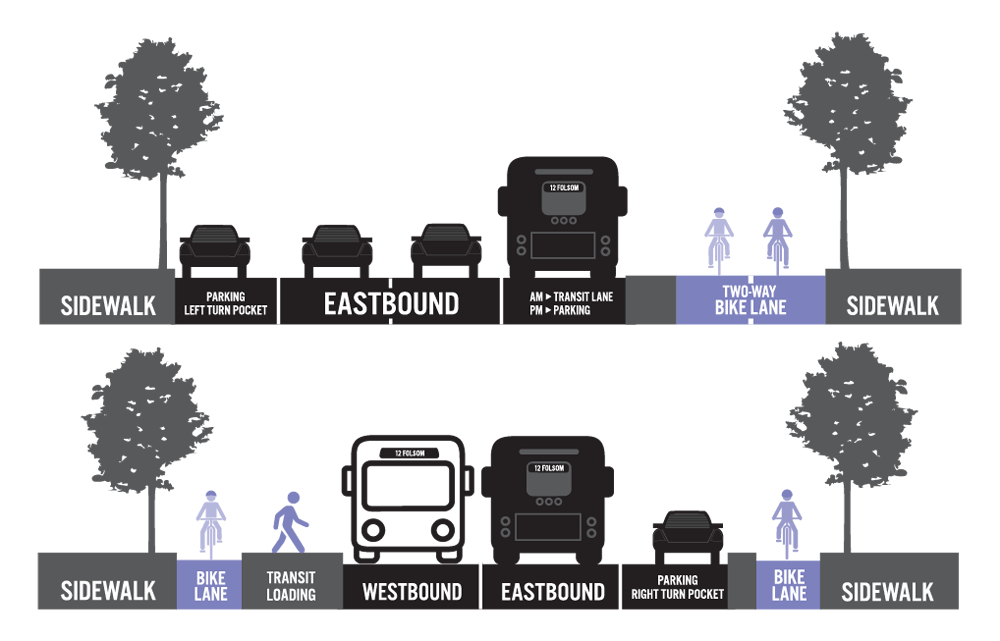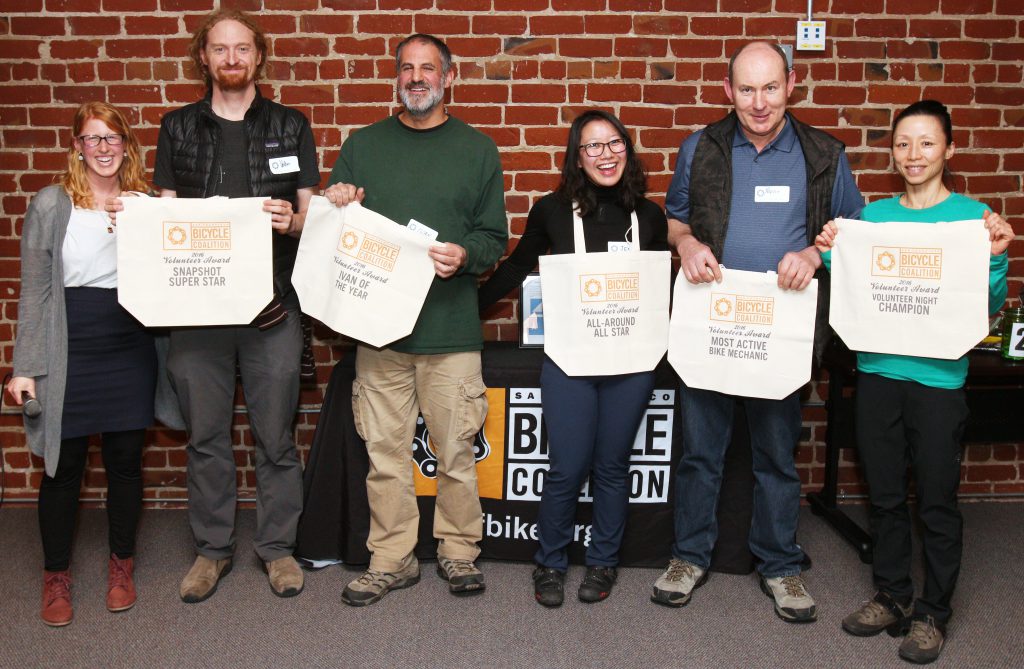Editors: This story was originally published in Issue 158 of our quarterly Tube Times magazine, one of many perks of membership in the San Francisco Bicycle Coalition.
The year is 2040. San Francisco’s South of Market (SoMa) neighborhood is everything a livable, sustainable community should be: Each street has been designed with people as the priority. Integrated transit lines meet up at the beautiful, iconic Transbay Terminal. Biking and walking are the best ways to get around and experience the neighborhood. Two key corridors, Folsom and Howard Streets, form the healthy, sustainable backbone of SoMa. The influx of new housing and job centers means that local businesses are thriving from all the foot traffic. With so many different transportation options available, getting around is more affordable than ever.
CALLING ALL CREATIVE MINDS: THE NEXT BIG THING IS HERE AND YOUR IMAGINATION IS NEEDED.
Over the next year, you have a seat at the table to make your vision for SoMa streets a reality. The SF Municipal Transportation Agency (SFMTA) is ready to launch a new project for Folsom and Howard Streets, and there will be numerous opportunities for you to speak up and weigh in.
Now close your eyes and think of how SoMa feels today. Cramped? Congested? Unwelcoming?
Anyone who spends time here knows that we feel the impacts of growth in few San Francisco neighborhoods as acutely as we do in SoMa. Yet SoMa streets like Folsom and Howard are often five or six lanes wide, encouraging the number-one cause of severe traffic collisions: Speeding. The mix of fast-moving vehicles within a dense, urban context unfortunately means that all the major corridors moving people through SoMa means more conflict. “High-injury corridors” identified by the SF Department of Health make up only 12 percent of city streets, yet are where more than 70 percent of severe and fatal traffic crashes occur. Few streets in SoMa do not bear inclusion in this list.
This means that low-income communities are disproportionately affected by traffic fatalities. A 2013 report done by the City’s Budget and Legislative Analyst found that Supervisorial District 6, which covers all of SoMa and the Tenderloin, had the lowest median household income and highest rates of poverty in San Francisco. According to the same report, District 6 also has the least amount of green space among all 11 districts and far more high-injury corridors than any other district.
San Franciscans deserve better. Over the next year, we invite you to join us in fighting for better streets and healthier places for residents who need them the most. We win when we invite everyone to the table and unite towards our common goals. Help us get there.
THE PLAN BEFORE THE PROJECT
In 2011, the City kicked off the Central SoMa Plan, recognizing the need to grow our downtown core as our city attracted more jobs and residents. The Plan sought to answer several key questions: How will we increase capacity for jobs and housing? How do we maintain the diversity of residents who call SoMa their home today? How can we expand open space? And how can we promote biking, walking and transit as the preferred means of getting around?
Six years of walking tours, community surveys, and countless meetings with community groups and neighborhood stakeholders was the first step in answering these questions. The City is now in the final stages of incorporating feedback, refining plans and completing environmental review. The next step is seeking the Board of Supervisors’ approval for those plans in mid-2017.
In order to accommodate growth, the City needed to plan for its infrastructure to-be, starting with its transportation networks. While the Central SoMa Plan was bounded by Second Street to the east and Sixth Street to the west, the City looked beyond those boundaries for two key corridors: Folsom and Howard Streets.
Using the groundwork laid by the Central SoMa Plan project thus far, the SFMTA launched their Folsom and Howard Streetscape Project in December 2016 to hone in on the ideal design for these two streets. The scope of this project extends from Second all the way to 11th. By the end of 2017, the SFMTA aims to approve physically protected bike lanes connecting the full length of the project as well as a suite of pedestrian, transit and livability improvements from better lighting to more open spaces.
MAKING OUR DREAMS COME TRUE
The work ahead is to join today’s infrastructure to the vision people dream of and deserve. Knowing our advocacy is strongest when informed and led by our membership, your San Francisco Bicycle Coalition surveyed members about your vision for SoMa and received nearly 500 responses. The results were clear: Streets need to be redesigned with people as the top priority.
What was most interesting was the feedback on design preferences. A few big picture design options were proposed by the Central SoMa Plan, and we included the conceptual images in our survey. Respondents preferred physically protected bike lanes going both directions on Folsom over adding lanes to Howard.

Design options under consideration for Folsom Street include a two-way protected bike lane (top) and separate physically protected bike lanes on either side of Folsom (bottom).
Given that 80 percent of respondents were concerned about dangerous intersections, we know that protected intersections are part of the answer, as well. Protected intersections, like SF’s first at Division and Ninth Streets, take the chaos out of crossing a street by adding physical barriers to separate people biking from vehicle traffic. They can add additional signage and signals along with raised crosswalks so that everyone is visible and knows when to cross. Protected intersections also employ treatments to slow speeds of turning traffic, further improving safety.
Seventy-four percent of survey respondents noted concerns about drivers entering the bike lanes. Survey results also showed that people want to see more greenery in SoMa. Bike lanes physically protected with concrete planters can solve both these problems by incorporating greenery and stopping drivers from entering the bike lane.
Now is the time to imagine the possibilities for every inch of asphalt, curb space and sidewalk in order to transform Folsom Street into the bike-friendly, walkable, people-first street we know it can be. Over the next year, the SFMTA will lead a series of open houses and other opportunities to solicit public feedback. And your San Francisco Bicycle Coalition will regularly convene our SoMa Member Committee, which launched last year and won approval of protected bike lanes on Seventh and Eighth Streets in November.
We know that the way to win these projects is bringing the whole neighborhood together and fighting for a vision of safe streets that serves everyone. That’s why it’s more important than ever that we reach out to our long-standing community partners, our allies in safe streets advocacy and other neighborhood leaders. Join us and tell everyone you know: Share your dream for SoMa with folks you know and welcome them to the table.
The Tube Times is published quarterly as one of the many benefits to members of the SF Bicycle Coalition. For a complete list of membership benefits, or to join/renew today, click here.


